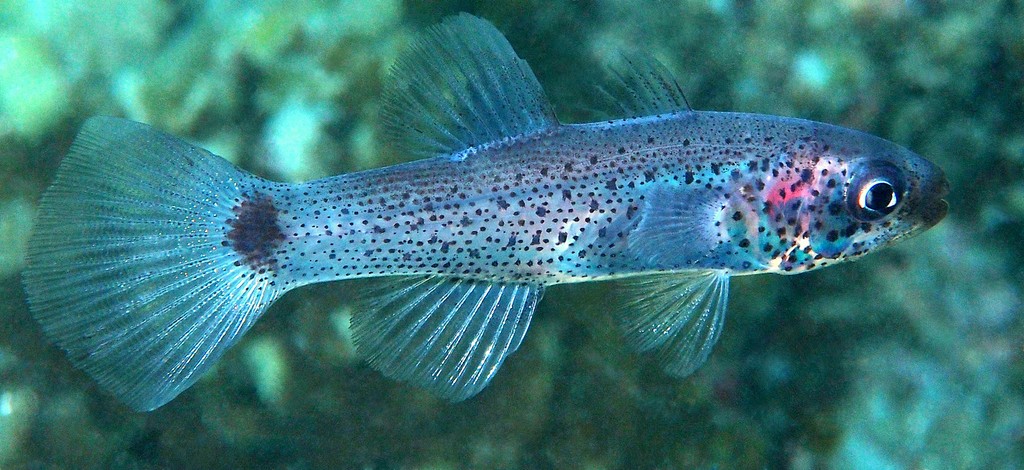PSEUDAMIA GELATINOSA - (SMITH, 1956)
Actinopterygii (Gigaclass) > Actinopteri (Class) > Teleostei (Subclass) > Gobiiformes (Order) > Apogonoidei (Suborder) > Apogonidae (Family) > Pseudamiinae (Subfamily) > Pseudamia (Genus)
Cardinal gélatineux, Gelatinous cardinalfish, Jelly cardinalfish, Tail-spot cardinalfish, Jelly cardinal, Jellie-kardinaal, Numeri-tenjikudai, ヌメリテンジクダイ, 大目側仔, 鈍尾擬天竺鯛,
Synonyme
Pseudamia gelantinosa (Smith, 1956)
---------------------------
Cardinal gélatineux, Gelatinous cardinalfish, Jelly cardinalfish, Tail-spot cardinalfish, Jelly cardinal, Jellie-kardinaal, Numeri-tenjikudai, ヌメリテンジクダイ, 大目側仔, 鈍尾擬天竺鯛,
Synonyme
Pseudamia gelantinosa (Smith, 1956)
---------------------------
Description
Dorsal spines (total): 7; Dorsal soft rays (total): 9; Anal spines: 2; Anal soft rays: 8; Pectoral fin rays: 15-17; Pelvic fin rays: I, 5; Pored lateral line scales: 35; Predorsal scales: 5-6; Circumpeduncular scales: 12; Total gill rakers: 11, developed gill rakers: 1 + 7; Anterior nostril flaps long; Scales in longitudinal series: 39-43; Lateral line not obvious, first few lateral line scales pored, remaining scales notched, and partial lateral line along abdomen with notched scales. Juveniles with strong triangular spinules around angle of preopercle that becomes undulate to smooth in adults. Pectoral fins reaching anal fin origin or slightly beyond. Caudal fin: 2.7-3.3 in SL. Caudal fin rounded. Preopercle ridge smooth, horizontal edge and corner serrate (serrae may be reduced in large adults). Mix of caniniform and villiform teeth on premaxillae and dentaries; Vomer and palatines with villiform teeth. Scales cycloid and deciduous; Max. length: 11.0 cm TL. Depth range: 1 - 64 m, usually: 1 - 40 m.
Color
Body translucent when fresh; Sides and ventral part of head light golden to silvery iridescent; Head and body with large brown spots with golden dot on the center; Posterior half of upper jaw light brown with dark brown spots. Dusky peritoneum with numerous black dots. Anterior nostril with long, darkly pigmented membranous flap. Dorsal part of caudal fin sometimes with an indistinct dark spot.
Dorsal spines (total): 7; Dorsal soft rays (total): 9; Anal spines: 2; Anal soft rays: 8; Pectoral fin rays: 15-17; Pelvic fin rays: I, 5; Pored lateral line scales: 35; Predorsal scales: 5-6; Circumpeduncular scales: 12; Total gill rakers: 11, developed gill rakers: 1 + 7; Anterior nostril flaps long; Scales in longitudinal series: 39-43; Lateral line not obvious, first few lateral line scales pored, remaining scales notched, and partial lateral line along abdomen with notched scales. Juveniles with strong triangular spinules around angle of preopercle that becomes undulate to smooth in adults. Pectoral fins reaching anal fin origin or slightly beyond. Caudal fin: 2.7-3.3 in SL. Caudal fin rounded. Preopercle ridge smooth, horizontal edge and corner serrate (serrae may be reduced in large adults). Mix of caniniform and villiform teeth on premaxillae and dentaries; Vomer and palatines with villiform teeth. Scales cycloid and deciduous; Max. length: 11.0 cm TL. Depth range: 1 - 64 m, usually: 1 - 40 m.
Color
Body translucent when fresh; Sides and ventral part of head light golden to silvery iridescent; Head and body with large brown spots with golden dot on the center; Posterior half of upper jaw light brown with dark brown spots. Dusky peritoneum with numerous black dots. Anterior nostril with long, darkly pigmented membranous flap. Dorsal part of caudal fin sometimes with an indistinct dark spot.
Etymology
Pseudamia: from Greek, pseudes = false + from Greek, amia, -as = a kind of bonito. Name given by Aristotle to a fish (Later name applied to Apogon by Gronow (1763), now a commonly used suffix in the family).
gelatinosa: from Latin, gelatus = frozen, congealed, having been frozen. Referring to its translucent body in life.
Original description: Pseudamia gelatinosa Smith, 1956 - Type locality: Aldabra Islands, Seychelles, western Indian Ocean.
Distribution
Red Sea; Indo-West Pacific: KwaZulu-Natal (South Africa), East Africa, Seychelles, Aldabra (Seychelles), Comoros, Madagascar and Mascarenes (Mauritius), east to Society Islands (French Polynesia), north to southern Japan, south to Western Australia and New Caledonia.
Pseudamia: from Greek, pseudes = false + from Greek, amia, -as = a kind of bonito. Name given by Aristotle to a fish (Later name applied to Apogon by Gronow (1763), now a commonly used suffix in the family).
gelatinosa: from Latin, gelatus = frozen, congealed, having been frozen. Referring to its translucent body in life.
Original description: Pseudamia gelatinosa Smith, 1956 - Type locality: Aldabra Islands, Seychelles, western Indian Ocean.
Distribution
Red Sea; Indo-West Pacific: KwaZulu-Natal (South Africa), East Africa, Seychelles, Aldabra (Seychelles), Comoros, Madagascar and Mascarenes (Mauritius), east to Society Islands (French Polynesia), north to southern Japan, south to Western Australia and New Caledonia.
Biology
Inhabits protected bays and lagoon reefs. Lives deep in coral thickets, thus is seldom seen by day (mainly nocturnal). Solitary. Distinct pairing during courtship and spawning.
Similar species
Pseudamia amblyuroptera (Bleeker, 1856) - Reported from Western Pacific: Singapore and Indonesia, east to Palau, Yap Island and New Ireland (Papua New Guinea), north to Philippines. It has more gill rakers and anal fin rays.
Inhabits protected bays and lagoon reefs. Lives deep in coral thickets, thus is seldom seen by day (mainly nocturnal). Solitary. Distinct pairing during courtship and spawning.
Similar species
Pseudamia amblyuroptera (Bleeker, 1856) - Reported from Western Pacific: Singapore and Indonesia, east to Palau, Yap Island and New Ireland (Papua New Guinea), north to Philippines. It has more gill rakers and anal fin rays.
Last update: 19, July 2024
